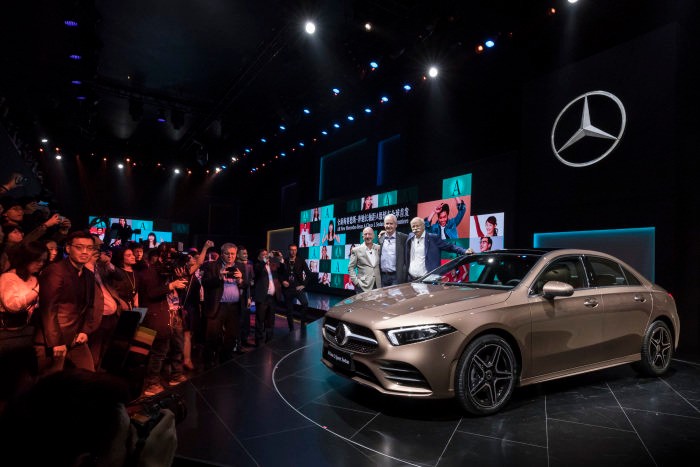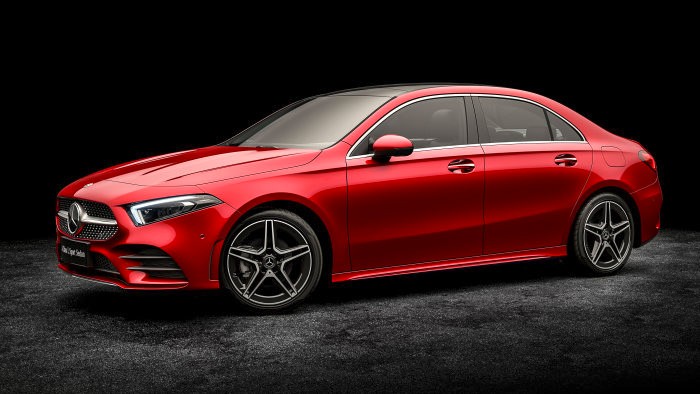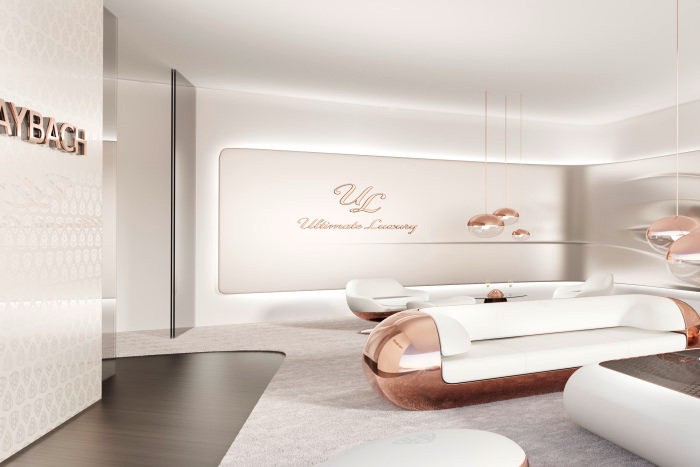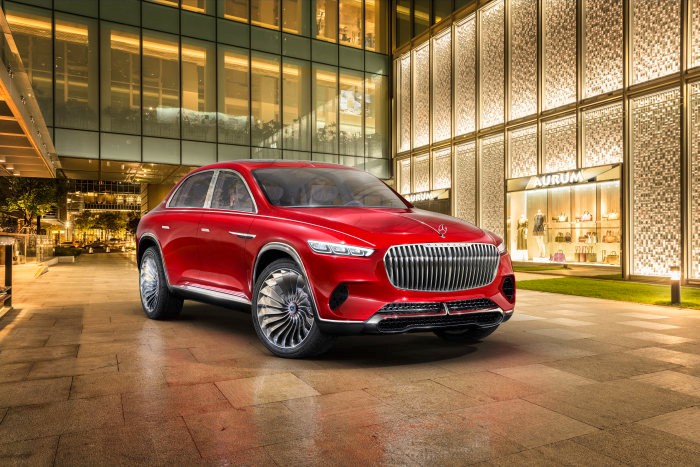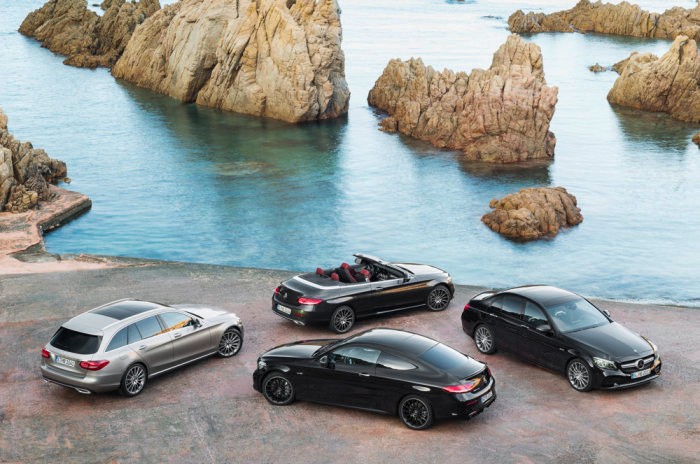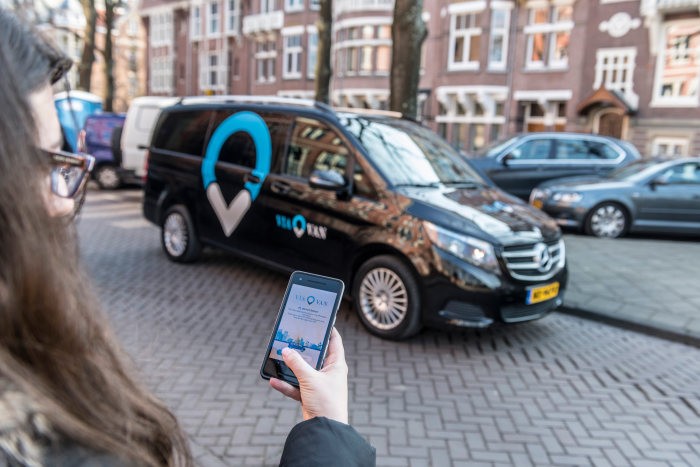24.
April 2018
Stuttgart/Beijing
Press Contact for this Press Release (2)
Willem Spelten
Head of international Brand & smart Product Communications
willem.spelten@daimler.com
Tel: +49 (0)711 17-75847
Fax: +49 (0)711 17-79099473
Lars Zeppenfeld
Manager Communications Design
lars.zeppenfeld@daimler.com
Tel: +49 (0)711 17-75834
Fax: +49 (0)711 17-91437
Stuttgart/Beijing. At “Auto China 2018” in Beijing, Mercedes-Benz is presenting the Vision Mercedes-Maybach Ultimate Luxury. The design of the crossover, based on an exclusive high-end saloon and an SUV, follows the philosophy of Sensual Purity. The show car combines the comfort and typical strengths of both body styles. These include the raised seating position and the athletic looks. The Vision Mercedes-Maybach Ultimate Luxury is conceived as an electric vehicle with four compact permanent-magnet synchronous motors and fully variable all-wheel drive.
“The Vision Mercedes-Maybach Ultimate Luxury is a totally new archetype of a kind never seen before,” says Gorden Wagener, Chief Design Officer at Daimler AG. “Our concept combines the DNA of an SUV with that of a saloon to produce an ultra-modern SUV of three-box design,” says Wagener. “With sensuality and pure sophistication, we have created a timeless vehicle that underscores the position of Mercedes-Maybach as the ultimate luxury brand.”
Continuing the Mercedes-Maybach success story
The concept vehicle not only embodies the Mercedes-Maybach design language, it also reflects the traditional brand values while continuing the successful Mercedes-Maybach story. True to the principle of creating “the very best from the very best”, Mercedes-Maybach stands for the ultimate in luxury while uniting the perfection of Mercedes-Benz with the exclusivity of Maybach.
The show car also merges influences from the Western and Far Eastern hemispheres to deliver an appealing automotive cultural dialogue. For instance, use is made of “Magic Wood”, ebony, which is traditional in Chinese furniture design. The same motif is also underlined by the combination of SUV and notchback saloon, which are the most successful body styles not only internationally, but especially on the Chinese market.
In the Vision Mercedes-Maybach Ultimate Luxury, spaciousness and comfort, in combination with the raised seating position, elegant design and finest materials, particularly in the rear, give rise to a luxury experience at the highest level. The vehicle stands in exemplary manner for the typical Mercedes-Maybach values: traditional craftsmanship, uniqueness and individualisation.
Exterior design: harmony of sensuality and purity
Smooth, extravagant surfaces with no beads or sharp edges create an image of sporty elegance: the Vision Mercedes-Maybach Ultimate Luxury has a majestic look. With its balanced proportions, the vehicle has tremendous presence.
The front end is accentuated by the distinctive chrome-plated radiator grille with its fine vertical bars in the style of a pinstripe suit. The new grille design celebrated its world premiere in the Vision Mercedes-Maybach 6, the exclusive coupé concept car that delighted aficionados and fans of the brand in 2016. It also inspired the latest reinterpretation for the Mercedes-Maybach S‑Class.
In combination with the low-profile front headlamps with three lamp units, the grille dominates the front view of the vehicle while emphasising its brand affiliation. The large air inlets along with the horizontal air inlet with integral chrome blades underline the sportiness of the SUV saloon while lending it a dynamic look. The air inlets are crossed by the brand's typical honeycomb pattern. A continuous trim strip extends from the split bonnet across the roof through to the rear end.
Unlike a conventional saloon, the Vision Mercedes-Maybach Ultimate Luxury offers a significantly higher, SUV-typical seating position and therefore a sublime driving experience. This addresses the desire of many customers for a feeling of protection and security – a challenge for the designers. Ultimately, the task was to harmoniously transfer the familiar three-box design – bonnet, passenger compartment and boot – to an SUV-like architecture. This produces an interesting tension between the poles of sportiness and Mercedes-Maybach luxury.
The upright C-pillar, long, gently forward-sloping bonnet and compact notchback dominate the sportily elegant side view. The muscular volume of the flank is accentuated by a long wheelbase and short rear overhangs. The overall appearance is rounded off by 24‑i nch turbine-look wheels.
Truncated running boards in machined aluminium are integrated in the lower door area. They are illuminated in white and bear the Maybach logo. The overall vehicle is accentuated by subtle chrome trim above the running boards as well as in the lower area of the front and rear ends. The electrically extending door handles are flush with the sides.
At the rear end, the three-part lamps are reminiscent of the design of the front headlamps. Situated above them is the visually vertically split rear window. Another striking feature is the modelled underride guard with diffuser look. It, too, is permeated by the Maybach pattern from the front end.
Sublimeness meets lightness: interior design
The interior of the Vision Mercedes-Maybach Ultimate Luxury features an exciting contrast between high-level sportiness and luxurious spaciousness. This show car is the ultimate embodiment of a luxury dream automobile. The goal of the interior designers was to provide echoes of the series-produced vehicles while, however, transporting them into an unprecedented world of luxury. They created a symbiosis of sportiness, modernity and elegance, giving an idea of coming generations of Mercedes-Maybach models.
Exclusive materials with high-grade highlights exude exquisite quality in the interior, thereby underlining the vehicle's superlative luxury. The generous feeling of spaciousness, together with the high-contrast colour compositions, make for a hitherto unattained luxury experience. The colours employed are typical of the brand, such as rosé gold, crystal white and pearl grey. Flowing forms, delicate fabrics and aluminium parts create an exciting contrast between the sportily elegant details of an SUV and the lightness of a saloon.
As the Vision Mercedes-Maybach Ultimate Luxury is intended primarily for chauffeur-driven use, its design is strongly focused on the rear passengers and their well-being. It is in the rear that the feeling of cosy spaciousness is at its most intense.
The driver's area and cockpit are reduced to the essentials. Air vents, which reflect the design of the radiator grille, surround the free-standing Widescreen Cockpit with double 12.3‑inch displays. The feeling of spaciousness is further enhanced by a light, contrasting bottom part of the instrument panel as well as by the reduced height of the dashboard. Overall, the interior creates an atmosphere of luxurious cosiness that allows the occupants to relax pleasantly. To emphasise the visual lightness, the rosé gold frame of the front seats is open, exposing the white leather to view. The colour/material scheme celebrates the superlative luxury of the Vision Mercedes-Maybach with exquisite materials and breathtaking surfaces.
The luxurious lightness of the interior is emphasised by the colours crystal white, finest nappa leather and a sensual shade of brown that features a light metallic finish on the instrument panel. Gleaming surfaces in polished aluminium generate exciting reflections while mirroring the highlight: the rosé gold-coated seats. The claim to the ultimate in luxury goes hand-in-hand with extreme technical challenges. For instance, the intense Mercedes-Maybach signature red metallic finish is applied by expert hand in several coats. Tradition and modernity are reflected in the form of appealing contrasts. The entire interior is surrounded by a large-area trim level. Dark ebony forms an exciting contrast with the surrounding areas of white leather. Wave-like, flowing lines of light are integrated flush into the wood surfaces, impressively uniting the analogue and digital worlds. The tailored seat upholstery layouts take up the lines of the trim while giving a reinterpretation to the typical diamond shape. The fine perforations are in rosé gold. Thought through down to the smallest detail, crafted with love and affection.
Modelled on the S-Class
As in the Mercedes-Maybach S-Class, the especially comfortable seats impress with their adjustment kinematics. Unlike in a conventional saloon, the backrest is adjusted separately while the footwell and seat reference point remain unchanged. The cushion can be adjusted separately, while the seat angle and height adjustment are combined. Extra-soft knee cushions afford protection and comfort. The reclining seats feature a calf support, which is freely adjustable for length and angle. The crystal white nappa leather seats are enhanced by diamond stitching in rosé gold.
The wide centre console extends through to the rear. It is equipped with an integral, heated tray with teapot and cups, allowing exquisite tea-drinking enjoyment while on the road. The philosophy of tea plays a key role in bringing body and mind into balance while discovering the path to inner calm and vitality.
The tea service is integrated into a sculpted wooden tray made of ebony, known as “Magic Wood”. At the press of a button, the handmade service of finest china can be electrically retracted into the console under a sliding cover finished in high-gloss black.
Enhanced user experience at the highest level
The Mercedes-Benz user experience, too, represents the definitive embodiment of a luxury dream car. The design language is warmer and brighter, creating a luxurious atmosphere. The car was created entirely in a 3D real-time graphic environment. Like a butler, the Vision Mercedes-Maybach Ultimate Luxury acts with anticipation, instead of offering long menus and lists. The vehicle plays music to match the current mood, knows the appointment calendar and plans the routes accordingly. In the rear, various flavours of tea and relaxation programmes are on offer, depending on who the rear passenger is.
The familiar ENERGIZING comfort control has been carried over from the S‑Class. Systems such as massage, fragrancing, light and music are combined, helping to regenerate and improve concentration. This holistic comfort and infotainment system can be individually programmed and adapted for every world market.
The highlight of the Mercedes-Benz user experience in the Vision Mercedes‑Maybach Ultimate Luxury is the comprehensive touch control concept – a combination of touchscreen, touchpad on the centre console and Touch Control buttons in the steering wheel. Alongside the intuitive control experience, reduced driver distraction is a further advantage.
The control concept of the free-standing Widescreen Cockpit comprises three levels with rising information density: home screen, base screen and a submenu. The voice control adjusts to the user's voice and adapts new vogue words or changed use of language. In addition, the system does not employ stereotypical responses, but uses interactive variation.
On the aesthetic front, it is based on the traditional Chinese ink painting style with its simplicity, white surfaces and balanced proportions.
State-of-the-art powertrain and suspension technology
The Vision Mercedes-Maybach Ultimate Luxury is conceived as an electric car. Thanks to its four compact permanent-magnet synchronous motors, it offers fully variable all-wheel drive. The output from the powertrain is 550 kW (750 hp). The flat underfloor battery has a usable capacity of around 80 kWh, producing an NEDC range of over 500 kilometres (according to EPA: over 200 miles). The top speed is electronically limited to 250 km/h.
The fast-charging function is also convenient: thanks to DC charging based on the CCS standard, the system allows a charging capacity of up to 350 kW. In just five minutes, enough power can be charged to achieve an additional range of around 100 kilometres.
The battery can be charged by cable at public charging stations, conventional domestic socket outlets or, even more conveniently, by induction. The charging current is contactlessly transmitted by an electromagnetic field below the car.
An eye on the future: visionary show cars
With its generous dimensions, the Vision Mercedes-Maybach Ultimate Luxury (length/width/height: 5260 x 2110 x 1764 millimetres) represents a continuation of the series of visionary design show cars from Mercedes-Benz. The series so far includes the Vision EnerG‑Force (Los Angeles, November 2012), AMG Vision Gran Turismo (Sunnyvale, 2013), Vision Tokyo (Tokyo, 2015), Vision Mercedes-Maybach 6 Coupé (Pebble Beach, 2016) and Vision Mercedes-Maybach 6 Cabriolet (Pebble Beach, 2017). Thanks to the global footprint of Mercedes-Benz Design, these concept vehicles take their cue from local trends in design, culture and mobility while making them the focal point of the respective mobility concept.
Mercedes-Maybach: perfection blended with exclusivity
Mercedes-Maybach stands for the ultimate in exclusivity and individuality. The target group includes customers who place value on exquisite luxury, perfect craftsmanship and exceptional appointments. The current vehicles include, launched in 2017, the Mercedes-Maybach S 560 4MATIC (combined fuel consumption: 9.3 l/100 km; combined CO2 emissions: 209 g/km). The absolute top-of-the range model from the luxury brand is the Pullman (combined fuel consumption: 14.6 l/100 km; combined CO2 emissions: 330 g/km) with vis-à-vis seating layout behind the partition. With a length of 6.50 metres, it is the longest model of the S‑Class family.
Download
Filter
Show thumbnails
Show list
Slideshow
Zoom
Preview
Details
Do you really want to delete the data record?
Please wait a moment …
Please wait a moment …
Please wait a moment …
Please wait a moment …
18C0325_001
18C0325_002
18C0325_003
18C0325_004
18C0325_005
18C0325_006
18C0325_007
18C0325_008
18C0325_009
18C0325_010
18C0325_011
18C0325_012
18C0325_013
18C0325_014
18C0325_015
18C0325_016
18C0325_017
18C0325_018
Loading

